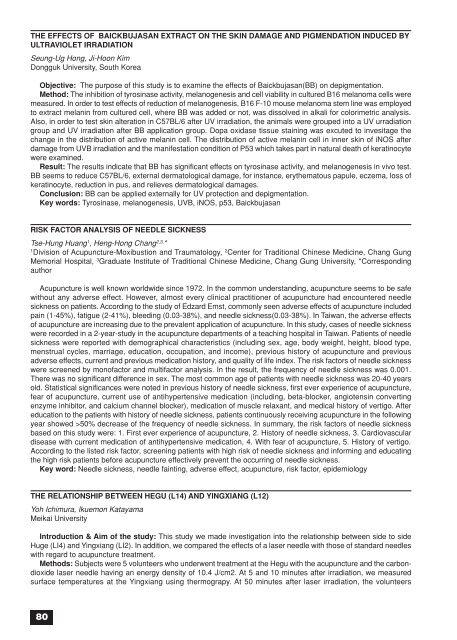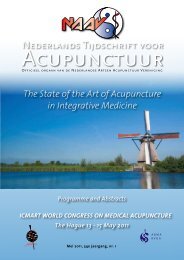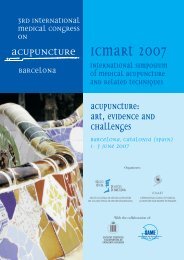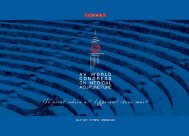Congress Abstracts full PDF - International Council of Medical ...
Congress Abstracts full PDF - International Council of Medical ...
Congress Abstracts full PDF - International Council of Medical ...
You also want an ePaper? Increase the reach of your titles
YUMPU automatically turns print PDFs into web optimized ePapers that Google loves.
THE EFFECTS OF BAICKBUJASAN EXTRACT ON THE SKIN DAMAGE AND PIGMENDATION INDUCED BY<br />
ULTRAVIOLET IRRADIATION<br />
Seung-Ug Hong, Ji-Hoon Kim<br />
Dongguk University, South Korea<br />
Objective: The purpose <strong>of</strong> this study is to examine the effects <strong>of</strong> Baickbujasan(BB) on depigmentation.<br />
Method: The inhibition <strong>of</strong> tyrosinase activity, melanogenesis and cell viability in cultured B16 melanoma cells were<br />
measured. In order to test effects <strong>of</strong> reduction <strong>of</strong> melanogenesis, B16 F-10 mouse melanoma stem line was employed<br />
to extract melanin from cultured cell, where BB was added or not, was dissolved in alkali for colorimetric analysis.<br />
Also, in order to test skin alteration in C57BL/6 after UV irradiation, the animals were grouped into a UV urradiation<br />
group and UV irradiation after BB application group. Dopa oxidase tissue staining was excuted to invesitage the<br />
change in the distribution <strong>of</strong> active melanin cell. The distribution <strong>of</strong> active melanin cell in inner skin <strong>of</strong> iNOS after<br />
damage from UVB irradiation and the manifestation condition <strong>of</strong> P53 which takes part in natural death <strong>of</strong> keratinocyte<br />
were examined.<br />
Result: The results indicate that BB has significant effects on tyrosinase activity, and melanogenesis in vivo test.<br />
BB seems to reduce C57BL/6, external dermatological damage, for instance, erythematous papule, eczema, loss <strong>of</strong><br />
keratinocyte, reduction in pus, and relieves dermatological damages.<br />
Conclusion: BB can be applied externally for UV protection and depigmentation.<br />
Key words: Tyrosinase, melanogenesis, UVB, iNOS, p53, Baickbujasan<br />
RISK FACTOR ANALYSIS OF NEEDLE SICKNESS<br />
Tse-Hung Huang 1 , Heng-Hong Chang 2,3, *<br />
1<br />
Division <strong>of</strong> Acupuncture-Moxibustion and Traumatology, 2 Center for Traditional Chinese Medicine, Chang Gung<br />
Memorial Hospital, 3 Graduate Institute <strong>of</strong> Traditional Chinese Medicine, Chang Gung University, *Corresponding<br />
author<br />
Acupuncture is well known worldwide since 1972. In the common understanding, acupuncture seems to be safe<br />
without any adverse effect. However, almost every clinical practitioner <strong>of</strong> acupuncture had encountered needle<br />
sickness on patients. According to the study <strong>of</strong> Edzard Emst, commonly seen adverse effects <strong>of</strong> acupuncture included<br />
pain (1-45%), fatigue (2-41%), bleeding (0.03-38%), and needle sickness(0.03-38%). In Taiwan, the adverse effects<br />
<strong>of</strong> acupuncture are increasing due to the prevalent application <strong>of</strong> acupuncture. In this study, cases <strong>of</strong> needle sickness<br />
were recorded in a 2-year-study in the acupuncture departments <strong>of</strong> a teaching hospital in Taiwan. Patients <strong>of</strong> needle<br />
sickness were reported with demographical characteristics (including sex, age, body weight, height, blood type,<br />
menstrual cycles, marriage, education, occupation, and income), previous history <strong>of</strong> acupuncture and previous<br />
adverse effects, current and previous medication history, and quality <strong>of</strong> life index. The risk factors <strong>of</strong> needle sickness<br />
were screened by mon<strong>of</strong>actor and multifactor analysis. In the result, the frequency <strong>of</strong> needle sickness was 0.001.<br />
There was no significant difference in sex. The most common age <strong>of</strong> patients with needle sickness was 20-40 years<br />
old. Statistical significances were noted in previous history <strong>of</strong> needle sickness, first ever experience <strong>of</strong> acupuncture,<br />
fear <strong>of</strong> acupuncture, current use <strong>of</strong> antihypertensive medication (including, beta-blocker, angiotensin converting<br />
enzyme inhibitor, and calcium channel blocker), medication <strong>of</strong> muscle relaxant, and medical history <strong>of</strong> vertigo. After<br />
education to the patients with history <strong>of</strong> needle sickness, patients continuously receiving acupuncture in the following<br />
year showed >50% decrease <strong>of</strong> the frequency <strong>of</strong> needle sickness. In summary, the risk factors <strong>of</strong> needle sickness<br />
based on this study were: 1. First ever experience <strong>of</strong> acupuncture, 2. History <strong>of</strong> needle sickness, 3. Cardiovascular<br />
disease with current medication <strong>of</strong> antihypertensive medication, 4. With fear <strong>of</strong> acupuncture, 5. History <strong>of</strong> vertigo.<br />
According to the listed risk factor, screening patients with high risk <strong>of</strong> needle sickness and informing and educating<br />
the high risk patients before acupuncture effectively prevent the occurring <strong>of</strong> needle sickness.<br />
Key word: Needle sickness, needle fainting, adverse effect, acupuncture, risk factor, epidemiology<br />
THE RELATIONSHIP BETWEEN HEGU (L14) AND YINGXIANG (L12)<br />
Yoh Ichimura, Ikuemon Katayama<br />
Meikai University<br />
Introduction & Aim <strong>of</strong> the study: This study we made investigation into the relationship between side to side<br />
Huge (LI4) and Yingxiang (LI2). In addition, we compared the effects <strong>of</strong> a laser needle with those <strong>of</strong> standard needles<br />
with regard to acupuncture treatment.<br />
Methods: Subjects were 5 volunteers who underwent treatment at the Hegu with the acupuncture and the carbondioxide<br />
laser needle having an energy density <strong>of</strong> 10.4 J/cm2. At 5 and 10 minutes after irradiation, we measured<br />
surface temperatures at the Yingxiang using thermograpy. At 50 minutes after laser irradiation, the volunteers<br />
80







